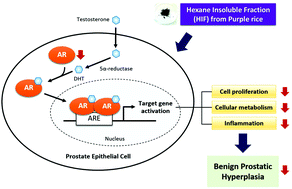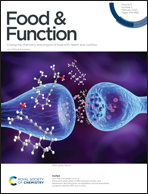Attenuation of benign prostatic hyperplasia by hydrophilic active compounds from pigmented rice in a testosterone implanted rat model
Abstract
Benign prostatic hyperplasia (BPH) is a common chronic disease in aging men. The present study aimed to identify the active fraction of a purple rice extract and determine its anti-prostatic hyperplasia effect in a testosterone implanted rat model. The hexane insoluble fraction (HIF) which mainly contains hydrophilic phytochemicals from the purple rice crude ethanolic extract was defined as the active fraction, due to a potent effect on the downregulation of androgen receptor (AR) expression in malignant prostate cells, in addition to low toxicity for normal fibroblast cells. To induce BPH, subcutaneous implanting of a testosterone containing tube was performed in the castrated rats. Oral administration of HIF of at least 0.1 g kg−1 retarded prostate enlargement and improved histological changes induced by testosterone, without any effects on the serum testosterone levels. A lower proliferating cell nuclear antigen (PCNA) labelling index and the downregulated expression of AR, cyclinD1, and fatty acid synthase were clearly observed in the prostates of HIF-fed rats. Additionally, the mRNA levels of inflammation-related cytokines and enzymes in the prostate tissues significantly decreased after HIF treatment. Taken together, these findings demonstrate molecular mechanisms underlying the potential protective effects of the purple rice active fraction against testosterone-induced BPH in rats.



 Please wait while we load your content...
Please wait while we load your content...